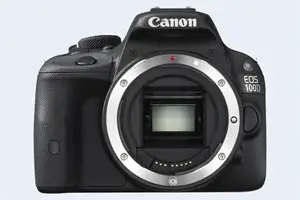Canon 100D vs Olympus E-PL8
The Canon EOS 100D (called Canon SL1 in some regions) and the Olympus PEN E-PL8 are two digital cameras that were officially introduced, respectively, in March 2013 and September 2016. The 100D is a DSLR, while the E-PL8 is a mirrorless interchangeable lens camera. The cameras are based on an APS-C (100D) and a Four Thirds (E-PL8) sensor. The Canon has a resolution of 17.9 megapixels, whereas the Olympus provides 15.9 MP.
Below is an overview of the main specs of the two cameras as a starting point for the comparison.

Check 100D offers at
ebay.com

Check E-PL8 offers at
ebay.com
Going beyond this snapshot of core features and characteristics, what are the differences between the Canon EOS 100D and the Olympus PEN E-PL8? Which one should you buy? Read on to find out how these two cameras compare with respect to their body size, their imaging sensors, their shooting features, their input-output connections, and their reception by expert reviewers.
Body comparison
An illustration of the physical size and weight of the Canon 100D and the Olympus E-PL8 is provided in the side-by-side display below. The two cameras are presented according to their relative size. Three successive views from the front, the top, and the rear are shown. All width, height and depth dimensions are rounded to the nearest millimeter.
The 100D can be obtained in two different colors (black, white), while the E-PL8 is available in three color-versions (black, brown, white).
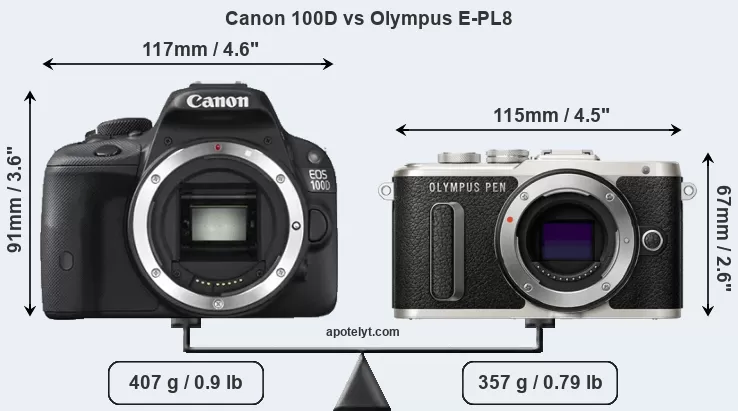
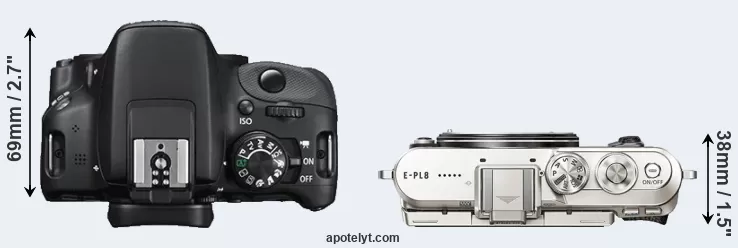
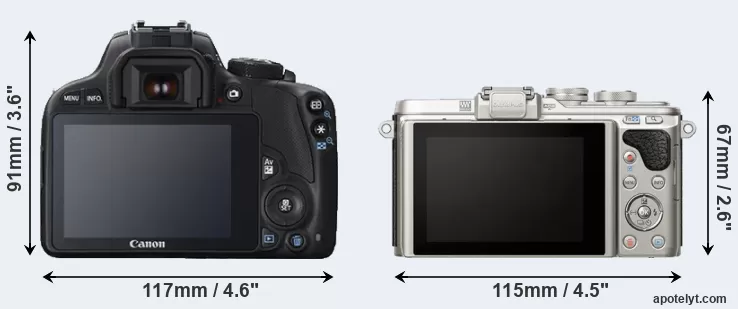
If the front view area (width x height) of the cameras is taken as an aggregate measure of their size, the Olympus E-PL8 is notably smaller (28 percent) than the Canon 100D. Moreover, the E-PL8 is markedly lighter (12 percent) than the 100D. In this context, it is worth noting that neither the 100D nor the E-PL8 are weather-sealed.
The above size and weight comparisons are to some extent incomplete since they do not consider the interchangeable lenses that both of these cameras require. A larger imaging sensor will tend to go along with bigger and heavier lenses, although exceptions exist. You can compare the optics available for the two cameras in the Canon EF Lens Catalog (100D) and the Micro Four Thirds Lens Catalog (E-PL8). Mirrorless cameras, such as the E-PL8, have moreover the advantage that they can use many lenses from other systems via adapters, as they have a relatively short flange to focal plane distance.
Concerning battery life, the 100D gets 380 shots out of its Canon LP-E12 battery, while the E-PL8 can take 350 images on a single charge of its Olympus BLS-50 power pack.
The following table provides a synthesis of the main physical specifications of the two cameras and other similar ones. If you would like to visualize and compare a different camera combination, you can navigate to the CAM-parator app and make your selection from a broad list of cameras there.

| Camera Model |
Camera Width |
Camera Height |
Camera Depth |
Camera Weight |
Battery Life |
Weather Sealing |
Camera Launch |
Launch Price |
Street Price |
||
|---|---|---|---|---|---|---|---|---|---|---|---|
| 1. | Canon 100D | 117 mm | 91 mm | 69 mm | 407 g | 380 | n | Mar 2013 | US$ 549 | ebay.com | |
| 2. | Olympus E-PL8 | 115 mm | 67 mm | 38 mm | 357 g | 350 | n | Sep 2016 | US$ 549 | ebay.com | |
| 3. | Canon 200D | 122 mm | 93 mm | 70 mm | 453 g | 650 | n | Jun 2017 | US$ 549 | ebay.com | |
| 4. | Canon 600D | 133 mm | 100 mm | 80 mm | 570 g | 440 | n | Feb 2011 | US$ 599 | ebay.com | |
| 5. | Canon 650D | 133 mm | 100 mm | 79 mm | 575 g | 440 | n | Jun 2012 | US$ 849 | ebay.com | |
| 6. | Canon 700D | 133 mm | 100 mm | 79 mm | 580 g | 440 | n | Mar 2013 | US$ 649 | ebay.com | |
| 7. | Canon 1200D | 130 mm | 100 mm | 78 mm | 480 g | 500 | n | Feb 2014 | US$ 449 | ebay.com | |
| 8. | Canon 1300D | 129 mm | 101 mm | 78 mm | 485 g | 500 | n | Mar 2016 | US$ 449 | ebay.com | |
| 9. | Canon 4000D | 129 mm | 102 mm | 77 mm | 436 g | 500 | n | Feb 2018 | US$ 399 | amazon.com | |
| 10. | Canon G16 | 109 mm | 76 mm | 40 mm | 356 g | 360 | n | Aug 2013 | US$ 549 | ebay.com | |
| 11. | Canon M | 109 mm | 66 mm | 32 mm | 298 g | 230 | n | Jul 2012 | US$ 599 | ebay.com | |
| 12. | Olympus E-M10 II | 120 mm | 83 mm | 47 mm | 390 g | 320 | n | Aug 2015 | US$ 649 | ebay.com | |
| 13. | Olympus E-M10 III | 122 mm | 84 mm | 50 mm | 410 g | 330 | n | Aug 2017 | US$ 649 | ebay.com | |
| 14. | Olympus E-PL7 | 115 mm | 67 mm | 38 mm | 357 g | 350 | n | Aug 2014 | US$ 599 | ebay.com | |
| 15. | Olympus E-PL9 | 117 mm | 68 mm | 39 mm | 380 g | 350 | n | Feb 2018 | US$ 599 | ebay.com | |
| 16. | Olympus E-PL10 | 117 mm | 68 mm | 39 mm | 380 g | 350 | n | Oct 2019 | US$ 599 | ebay.com | |
| 17. | Panasonic G6 | 122 mm | 85 mm | 71 mm | 390 g | 340 | n | Apr 2013 | US$ 599 | ebay.com | |
| Note: Measurements and pricing do not include easily detachable parts, such as add-on or interchangeable lenses or optional viewfinders. | |||||||||||
Any camera decision will obviously take relative prices into account. The manufacturer’s suggested retail prices give an idea on the placement of the camera in the maker’s lineup and the broader market. The two cameras under review were launched at the same price and fall into the same market segment. Normally, street prices remain initially close to the MSRP, but after a couple of months, the first discounts appear. Later in the product cycle and, in particular, when the replacement model is about to appear, further discounting and stock clearance sales often push the camera price considerably down.
Sensor comparison
The size of the sensor inside a digital camera is one of the key determinants of image quality. All other things equal, a large sensor will have larger individual pixel-units that offer better low-light sensitivity, wider dynamic range, and richer color-depth than smaller pixels in a sensor of the same technological generation. Furthermore, a large sensor camera will give the photographer more possibilities to use shallow depth-of-field in order to isolate a subject from the background. On the downside, larger sensors are more costly to manufacture and tend to lead to bigger and heavier cameras and lenses.
Of the two cameras under consideration, the Canon 100D features an APS-C sensor and the Olympus E-PL8 a Four Thirds sensor. The sensor area in the E-PL8 is 32 percent smaller. As a result of these sensor size differences, the cameras have a format factor of, respectively, 1.6 and 2.0. The sensor in the 100D has a native 3:2 aspect ratio, while the one in the E-PL8 offers a 4:3 aspect.
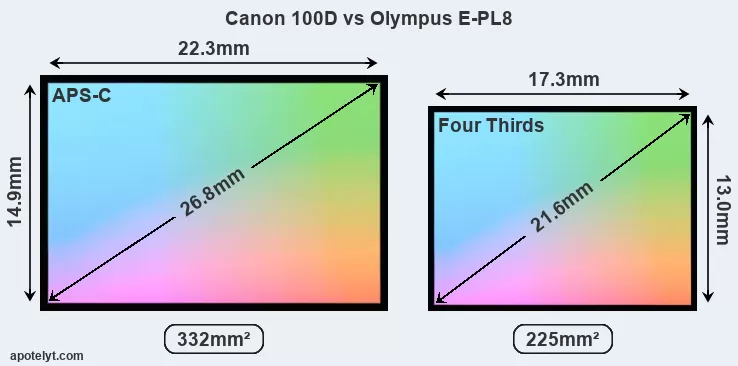
With 17.9MP, the 100D offers a higher resolution than the E-PL8 (15.9MP), but the 100D nevertheless has larger individual pixels (pixel pitch of 4.31μm versus 3.76μm for the E-PL8) due to its larger sensor. However, the E-PL8 is a much more recent model (by 3 years and 6 months) than the 100D, and its sensor will have benefitted from technological advances during this time that further enhance the light gathering capacity of its pixels.
The resolution advantage of the Canon 100D implies greater flexibility for cropping images or the possibility to print larger pictures. The maximum print size of the 100D for good quality output (200 dots per inch) amounts to 25.9 x 17.3 inches or 65.8 x 43.9 cm, for very good quality (250 dpi) 20.7 x 13.8 inches or 52.7 x 35.1 cm, and for excellent quality (300 dpi) 17.3 x 11.5 inches or 43.9 x 29.3 cm. The corresponding values for the Olympus E-PL8 are 23 x 17.3 inches or 58.5 x 43.9 cm for good quality, 18.4 x 13.8 inches or 46.8 x 35.1 cm for very good quality, and 15.4 x 11.5 inches or 39 x 29.3 cm for excellent quality prints.
The 100D has on-sensor phase detect pixels, which results in fast and reliable autofocus acquisition even during live view operation.
The Canon EOS 100D has a native sensitivity range from ISO 100 to ISO 12800, which can be extended to ISO 100-25600. The corresponding ISO settings for the Olympus PEN E-PL8 are ISO 200 to ISO 6400, with the possibility to increase the ISO range to 100-25600.
Technology-wise, both cameras are equipped with CMOS (Complementary Metal–Oxide–Semiconductor) sensors. Both cameras use a Bayer filter for capturing RGB colors on a square grid of photosensors. This arrangement is found in most digital cameras.
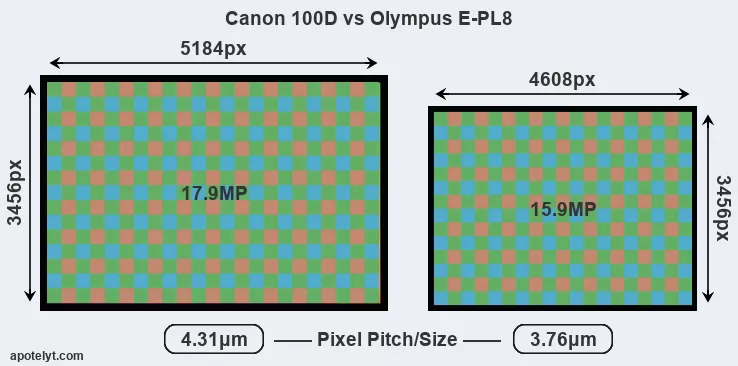
For many cameras, data on sensor performance has been reported by DXO Mark. This service is based on lab testing and assigns an overall score to each camera sensor, as well as ratings for dynamic range ("DXO Landscape"), color depth ("DXO Portrait"), and low-light sensitivity ("DXO Sports"). The adjacent table reports on the physical sensor characteristics and the outcomes of the DXO sensor quality tests for a sample of comparator-cameras.

| Camera Model |
Sensor Class |
Resolution (MP) |
Horiz. Pixels |
Vert. Pixels |
Video Format |
DXO Portrait |
DXO Landscape |
DXO Sports |
DXO Overall |
||
|---|---|---|---|---|---|---|---|---|---|---|---|
| 1. | Canon 100D | APS-C | 17.9 | 5184 | 3456 | 1080/30p | 21.8 | 11.3 | 843 | 63 | |
| 2. | Olympus E-PL8 | Four Thirds | 15.9 | 4608 | 3456 | 1080/30p | 23.0 | 12.6 | 1030 | 73 | |
| 3. | Canon 200D | APS-C | 24.0 | 6000 | 4000 | 1080/60p | 23.6 | 13.4 | 1041 | 79 | |
| 4. | Canon 600D | APS-C | 17.9 | 5184 | 3456 | 1080/30p | 22.1 | 11.5 | 793 | 65 | |
| 5. | Canon 650D | APS-C | 17.9 | 5184 | 3456 | 1080/30p | 21.7 | 11.2 | 722 | 62 | |
| 6. | Canon 700D | APS-C | 17.9 | 5184 | 3456 | 1080/30p | 21.7 | 11.2 | 681 | 61 | |
| 7. | Canon 1200D | APS-C | 17.9 | 5184 | 3456 | 1080/30p | 21.9 | 11.3 | 724 | 63 | |
| 8. | Canon 1300D | APS-C | 17.9 | 5184 | 3456 | 1080/30p | 22.0 | 11.7 | 781 | 66 | |
| 9. | Canon 4000D | APS-C | 17.9 | 5184 | 3456 | 1080/30p | 21.9 | 11.4 | 695 | 63 | |
| 10. | Canon G16 | 1/1.7 | 12.0 | 4000 | 3000 | 1080/60p | 21.0 | 11.7 | 230 | 54 | |
| 11. | Canon M | APS-C | 17.9 | 5184 | 3456 | 1080/30p | 22.1 | 11.2 | 827 | 65 | |
| 12. | Olympus E-M10 II | Four Thirds | 15.9 | 4608 | 3456 | 1080/60p | 23.1 | 12.5 | 842 | 73 | |
| 13. | Olympus E-M10 III | Four Thirds | 15.9 | 4608 | 3456 | 4K/30p | 23.1 | 12.8 | 1120 | 74 | |
| 14. | Olympus E-PL7 | Four Thirds | 15.9 | 4608 | 3456 | 1080/30p | 22.7 | 12.4 | 873 | 72 | |
| 15. | Olympus E-PL9 | Four Thirds | 15.9 | 4608 | 3456 | 4K/30p | 23.1 | 12.8 | 1162 | 74 | |
| 16. | Olympus E-PL10 | Four Thirds | 15.9 | 4608 | 3456 | 4K/30p | 23.3 | 13.1 | 1324 | 76 | |
| 17. | Panasonic G6 | Four Thirds | 15.9 | 4608 | 3456 | 1080/60p | 21.3 | 11.5 | 639 | 61 | |
| Note: DXO values in italics represent estimates based on sensor size and age. | |||||||||||
Many modern cameras are not only capable of taking still images, but can also record movies. The two cameras under consideration both have sensors whose read-out speed is fast enough to capture moving pictures, and both provide the same movie specifications (1080/30p).
Feature comparison
Apart from body and sensor, cameras can and do differ across a range of features. For example, the 100D has an optical viewfinder, which can be very useful when shooting in bright sunlight. In contrast, the E-PL8 relies on live view and the rear LCD for framing. That said, the E-PL8 can be equipped with an optional viewfinder – the VF-4. The following table reports on some other key feature differences and similarities of the Canon 100D, the Olympus E-PL8, and comparable cameras.

| Camera Model |
Viewfinder (Type or 000 dots) |
Control Panel (yes/no) |
LCD Specifications (inch/000 dots) |
LCD Attach- ment |
Touch Screen (yes/no) |
Max Shutter Speed * |
Max Shutter Flaps * |
Built-in Flash (yes/no) |
Built-in Image Stab |
||
|---|---|---|---|---|---|---|---|---|---|---|---|
| 1. | Canon 100D | optical | n | 3.0 / 1040 | fixed | Y | 1/4000s | 4.9/s | Y | n | |
| 2. | Olympus E-PL8 | optional | n | 3.0 / 1037 | tilting | Y | 1/4000s | 8.0/s | n | Y | |
| 3. | Canon 200D | optical | n | 3.0 / 1040 | swivel | Y | 1/4000s | 5.0/s | Y | n | |
| 4. | Canon 600D | optical | n | 3.0 / 1040 | swivel | n | 1/4000s | 3.7/s | Y | n | |
| 5. | Canon 650D | optical | n | 3.0 / 1040 | swivel | Y | 1/4000s | 5.0/s | Y | n | |
| 6. | Canon 700D | optical | n | 3.0 / 1040 | swivel | Y | 1/4000s | 5.0/s | Y | n | |
| 7. | Canon 1200D | optical | n | 3.0 / 460 | fixed | n | 1/4000s | 3.0/s | Y | n | |
| 8. | Canon 1300D | optical | n | 3.0 / 920 | fixed | n | 1/4000s | 3.0/s | Y | n | |
| 9. | Canon 4000D | optical | n | 2.7 / 230 | fixed | n | 1/4000s | 3.0/s | Y | n | |
| 10. | Canon G16 | optical | n | 3.0 / 922 | fixed | n | 1/4000s | 2.2/s | Y | Y | |
| 11. | Canon M | none | n | 3.0 / 1040 | fixed | Y | 1/4000s | 4.3/s | n | n | |
| 12. | Olympus E-M10 II | 2360 | n | 3.0 / 1040 | tilting | Y | 1/4000s | 8.0/s | Y | Y | |
| 13. | Olympus E-M10 III | 2360 | n | 3.0 / 1040 | tilting | Y | 1/4000s | 8.6/s | Y | Y | |
| 14. | Olympus E-PL7 | optional | n | 3.0 / 1037 | tilting | Y | 1/4000s | 8.0/s | n | Y | |
| 15. | Olympus E-PL9 | none | n | 3.0 / 1040 | tilting | Y | 1/4000s | 8.6/s | Y | Y | |
| 16. | Olympus E-PL10 | none | n | 3.0 / 1040 | tilting | Y | 1/4000s | 8.6/s | Y | Y | |
| 17. | Panasonic G6 | 1440 | n | 3.0 / 1036 | swivel | Y | 1/4000s | 7.0/s | Y | n | |
| Note: *) Information refers to the mechanical shutter, unless the camera only has an electronic one. | |||||||||||
One difference between the cameras concerns the presence of an on-board flash. The 100D has one, while the E-PL8 does not. While the built-in flash of the 100D is not very powerful, it can at times be useful as a fill-in light.
The E-PL8 has an articulated screen that can be turned to be front-facing. This characteristic will be appreciated by vloggers and photographers who are interested in taking selfies. In contrast, the 100D does not have a selfie-screen.The Olympus E-PL8 has an intervalometer built-in. This enables the photographer to capture time lapse sequences, such as flower blooming, a sunset or moon rise, without purchasing an external camera trigger and related software.
Concerning the storage of imaging data, both the 100D and the E-PL8 write their files to SDXC cards. Both cameras can use UHS-I cards, which provide for Ultra High Speed data transfer of up to 104 MB/s.
Connectivity comparison
For some imaging applications, the extent to which a camera can communicate with its environment can be an important aspect in the camera decision process. The table below provides an overview of the connectivity of the Canon EOS 100D and Olympus PEN E-PL8 and, in particular, the interfaces the cameras (and selected comparators) provide for accessory control and data transfer.

| Camera Model |
Hotshoe Port |
Internal Mic / Speaker |
Microphone Port |
Headphone Port |
HDMI Port |
USB Port |
WiFi Support |
NFC Support |
Bluetooth Support |
||
|---|---|---|---|---|---|---|---|---|---|---|---|
| 1. | Canon 100D | Y | mono / mono | Y | - | mini | 2.0 | - | - | - | |
| 2. | Olympus E-PL8 | Y | stereo / mono | - | - | micro | 2.0 | Y | - | - | |
| 3. | Canon 200D | Y | stereo / mono | Y | - | mini | 2.0 | Y | Y | Y | |
| 4. | Canon 600D | Y | mono / mono | Y | - | mini | 2.0 | - | - | - | |
| 5. | Canon 650D | Y | stereo / mono | Y | - | mini | 2.0 | - | - | - | |
| 6. | Canon 700D | Y | stereo / mono | Y | - | mini | 2.0 | - | - | - | |
| 7. | Canon 1200D | Y | mono / mono | - | - | mini | 2.0 | - | - | - | |
| 8. | Canon 1300D | Y | mono / mono | - | - | mini | 2.0 | Y | Y | - | |
| 9. | Canon 4000D | Y | mono / mono | - | - | mini | 2.0 | Y | Y | - | |
| 10. | Canon G16 | Y | stereo / mono | - | - | mini | 2.0 | Y | - | - | |
| 11. | Canon M | Y | stereo / mono | Y | - | mini | 2.0 | - | - | - | |
| 12. | Olympus E-M10 II | Y | stereo / mono | - | - | micro | 2.0 | Y | - | - | |
| 13. | Olympus E-M10 III | Y | stereo / mono | - | - | micro | 2.0 | Y | - | - | |
| 14. | Olympus E-PL7 | Y | stereo / mono | - | - | micro | 2.0 | Y | - | - | |
| 15. | Olympus E-PL9 | Y | stereo / mono | - | - | micro | 2.0 | Y | - | Y | |
| 16. | Olympus E-PL10 | Y | stereo / mono | - | - | micro | 2.0 | Y | - | Y | |
| 17. | Panasonic G6 | Y | stereo / mono | Y | - | mini | 2.0 | Y | Y | - |
It is notable that the 100D has a microphone port, which is missing on the E-PL8. Such an external microphone input can help to substantially improve the quality of audio recordings when a good external microphone is used.
Both the 100D and the E-PL8 have been discontinued, but can regularly be found used on ebay. The 100D was replaced by the Canon 200D, while the E-PL8 was followed by the Olympus E-PL9. Further information on the features and operation of the 100D and E-PL8 can be found, respectively, in the Canon 100D Manual (free pdf) or the online Olympus E-PL8 Manual.
Review summary
So what conclusions can be drawn? Is there a clear favorite between the Canon 100D and the Olympus E-PL8? Which camera is better? The listing below highlights the relative strengths of the two models.

Arguments in favor of the Canon EOS 100D:
- More detail: Offers more megapixels (17.9 vs 15.9MP) with a 8% higher linear resolution.
- Better image quality: Features bigger pixels on a larger sensor for higher quality imaging.
- Richer colors: The pixel size advantage translates into images with better, more accurate colors.
- More dynamic range: Larger pixels capture a wider spectrum of light and dark details.
- Better low-light sensitivity: Larger pixels means good image quality even under poor lighting.
- Better live-view autofocus: Features on-sensor phase-detection for more confident autofocus.
- Better sound: Can connect to an external microphone for higher quality sound recording.
- Easier framing: Has an optical viewfinder for image composition and settings control.
- Easier fill-in: Is equipped with a small onboard flash to brighten deep shadow areas.
- More heavily discounted: Has been available for much longer (launched in March 2013).

Reasons to prefer the Olympus PEN E-PL8:
- More flexible LCD: Has a tilting screen for odd-angle shots in landscape orientation.
- More selfie-friendly: Has an articulated screen that can be turned to be front-facing.
- Faster burst: Shoots at higher frequency (8 vs 4.9 flaps/sec) to capture the decisive moment.
- Easier time-lapse photography: Has an intervalometer built-in for low frequency shooting.
- More compact: Is smaller (115x67mm vs 117x91mm) and will fit more readily into a bag.
- Less heavy: Has a lower weight (by 50g or 12 percent) and is thus easier to take along.
- Sharper images: Has stabilization technology built-in to reduce the impact of hand-shake.
- More legacy lens friendly: Can use many non-native lenses via adapters.
- Easier file upload: Has wifi built in for automatic backup or image transfer to the web.
- More modern: Reflects 3 years and 6 months of technical progress since the 100D launch.
If the count of relative strengths (bullet points above) is taken as a measure, the match-up finishes in a tie (10 points each). However, the pertinence of the various camera strengths will differ across photographers, so that you might want to weigh individual camera traits according to their importance for your own imaging needs before making a camera decision. A professional wedding photographer will view the differences between cameras in a way that diverges from the perspective of a travel photog, and a person interested in cityscapes has distinct needs from a macro shooter. Hence, the decision which camera is best and worth buying is often a very personal one.
How about other alternatives? Do the specifications of the Canon 100D and the Olympus E-PL8 place the cameras among the top in their class? Find out in the latest Best DSLR Camera and Best Mirrorless Interchangeable Lens Camera listings whether the two cameras rank among the cream of the crop.
In any case, while the specs-based evaluation of cameras can be instructive in revealing their potential as photographic tools, it says little about, for example, the shooting experience and imaging performance of the 100D and the E-PL8 in practical situations. At times, user reviews, such as those published at amazon, address these issues in a useful manner, but such feedback is on many occasions incomplete, inconsistent, and unreliable.
Expert reviews
This is why hands-on reviews by experts are important. The adjacent summary-table relays the overall verdicts of several of the most popular camera review sites (amateurphotographer [AP], cameralabs [CL], digitalcameraworld [DCW], dpreview [DPR], ephotozine [EPZ], photographyblog [PB]). As can be seen, the professional reviewers agree in many cases on the quality of different cameras, but sometimes their assessments diverge, reinforcing the earlier point that a camera decision is often a very personal choice.

| Camera Model |
AP score |
CL score |
DCW score |
DPR score |
EPZ score |
PB score |
Camera Launch |
Launch Price |
Street Price |
||
|---|---|---|---|---|---|---|---|---|---|---|---|
| 1. | Canon 100D | 4/5 | + | .. | 78/100 | 4/5 | 4/5 | Mar 2013 | US$ 549 | ebay.com | |
| 2. | Olympus E-PL8 | .. | .. | .. | .. | 4.5/5 | 4/5 | Sep 2016 | US$ 549 | ebay.com | |
| 3. | Canon 200D | 4/5 | + + | 4/5 | 78/100 | 4.5/5 | 4.5/5 | Jun 2017 | US$ 549 | ebay.com | |
| 4. | Canon 600D | 3/5 | o | .. | 77/100 | 4.5/5 | 4.5/5 | Feb 2011 | US$ 599 | ebay.com | |
| 5. | Canon 650D | 4/5 | + + | .. | 77/100 | 4.5/5 | 4.5/5 | Jun 2012 | US$ 849 | ebay.com | |
| 6. | Canon 700D | .. | .. | .. | 76/100 | 4.5/5 | 4.5/5 | Mar 2013 | US$ 649 | ebay.com | |
| 7. | Canon 1200D | 3/5 | + | .. | .. | 4/5 | 4.5/5 | Feb 2014 | US$ 449 | ebay.com | |
| 8. | Canon 1300D | 4/5 | o | 4/5 | 73/100 | 4/5 | 4/5 | Mar 2016 | US$ 449 | ebay.com | |
| 9. | Canon 4000D | 2.5/5 | o | 3/5 | .. | 3.5/5 | 3.5/5 | Feb 2018 | US$ 399 | amazon.com | |
| 10. | Canon G16 | 4/5 | + | .. | .. | 4.5/5 | 4.5/5 | Aug 2013 | US$ 549 | ebay.com | |
| 11. | Canon M | 3/5 | + | .. | .. | 4/5 | 4/5 | Jul 2012 | US$ 599 | ebay.com | |
| 12. | Olympus E-M10 II | 4.5/5 | + + | .. | 80/100 | 5/5 | 5/5 | Aug 2015 | US$ 649 | ebay.com | |
| 13. | Olympus E-M10 III | .. | + | 5/5 | 80/100 | 4.5/5 | 4.5/5 | Aug 2017 | US$ 649 | ebay.com | |
| 14. | Olympus E-PL7 | 4/5 | + | .. | .. | 5/5 | 4/5 | Aug 2014 | US$ 599 | ebay.com | |
| 15. | Olympus E-PL9 | .. | + | .. | .. | 4.5/5 | 4/5 | Feb 2018 | US$ 599 | ebay.com | |
| 16. | Olympus E-PL10 | .. | .. | 4/5 | 77/100 | .. | 4/5 | Oct 2019 | US$ 599 | ebay.com | |
| 17. | Panasonic G6 | 4/5 | + + | .. | .. | 5/5 | 4.5/5 | Apr 2013 | US$ 599 | ebay.com | |
| Note: (+ +) highly recommended; (+) recommended; (o) reviewed; (..) not available. | |||||||||||
Care should be taken when interpreting the review scores above, though. The assessments were made in relation to similar cameras of the same technological generation. A score, therefore, has to be seen in close connection to the price and market introduction time of the camera, and rating-comparisons among cameras that span long time periods or concern very differently equipped models make little sense. Also, kindly note that some of the listed sites have over time developped their review approaches and their reporting style.

Check 100D offers at
ebay.com

Check E-PL8 offers at
ebay.com
Other camera comparisons
Did this review help to inform your camera decision process? In case you would like to check on the differences and similarities of other camera models, just use the search menu below. As an alternative, you can also directly jump to any one of the listed comparisons that were previously generated by the CAM-parator tool.
- Canon 100D vs Canon 90D
- Canon 100D vs Canon G7 X Mark III
- Canon 100D vs Canon M50
- Canon 100D vs Fujifilm X-Pro1
- Canon 100D vs Leica D-LUX 6
- Canon 100D vs Nikon D5200
- Canon 500D vs Olympus E-PL8
- Canon SX730 vs Olympus E-PL8
- Fujifilm GFX 50R vs Olympus E-PL8
- Hasselblad X1D II vs Olympus E-PL8
- Olympus E-M5 III vs Olympus E-PL8
- Olympus E-PL8 vs Ricoh GR
Specifications: Canon 100D vs Olympus E-PL8
Below is a side-by-side comparison of the specs of the two cameras to facilitate a quick review of their differences and common features.
| Camera Model | Canon 100D | Olympus E-PL8 |
|---|---|---|
| Camera Type | Digital single lens reflex | Mirrorless system camera |
| Camera Lens | Canon EF mount lenses | Micro Four Thirds lenses |
| Launch Date | March 2013 | September 2016 |
| Launch Price | USD 549 | USD 549 |
| Sensor Specs | Canon 100D | Olympus E-PL8 |
| Sensor Technology | CMOS | CMOS |
| Sensor Format | APS-C Sensor | Four Thirds Sensor |
| Sensor Size | 22.3 x 14.9 mm | 17.3 x 13.0 mm |
| Sensor Area | 332.27 mm2 | 224.9 mm2 |
| Sensor Diagonal | 26.8 mm | 21.6 mm |
| Crop Factor | 1.6x | 2.0x |
| Sensor Resolution | 17.9 Megapixels | 15.9 Megapixels |
| Image Resolution | 5184 x 3456 pixels | 4608 x 3456 pixels |
| Pixel Pitch | 4.31 μm | 3.76 μm |
| Pixel Density | 5.39 MP/cm2 | 7.08 MP/cm2 |
| Moiré control | Anti-Alias filter | Anti-Alias filter |
| Movie Capability | 1080/30p Video | 1080/30p Video |
| ISO Setting | 100 - 12,800 ISO | 200 - 6,400 ISO |
| ISO Boost | 100 - 25,600 ISO | 100 - 25,600 ISO |
| Image Processor | DIGIC 5 | TruePic VII |
| DXO Sensor Quality (score) | 63 | .. |
| DXO Color Depth (bits) | 21.8 | .. |
| DXO Dynamic Range (EV) | 11.3 | .. |
| DXO Low Light (ISO) | 843 | .. |
| Screen Specs | Canon 100D | Olympus E-PL8 |
| Viewfinder Type | Optical viewfinder | Viewfinder optional |
| Viewfinder Field of View | 95% | |
| Viewfinder Magnification | 0.54x | |
| LCD Framing | Live View | Live View |
| Rear LCD Size | 3.0inch | 3.0inch |
| LCD Resolution | 1040k dots | 1037k dots |
| LCD Attachment | Fixed screen | Tilting screen |
| Touch Input | Touchscreen | Touchscreen |
| Shooting Specs | Canon 100D | Olympus E-PL8 |
| Focus System | Phase-detect AF | Contrast-detect AF |
| Manual Focusing Aid | no Peaking Feature | Focus Peaking |
| Max Shutter Speed (mechanical) | 1/4000s | 1/4000s |
| Continuous Shooting | 4.9 shutter flaps/s | 8 shutter flaps/s |
| Time-Lapse Photography | no Intervalometer | Intervalometer built-in |
| Image Stabilization | Lens stabilization only | In-body stabilization |
| Fill Flash | Built-in Flash | no On-Board Flash |
| Storage Medium | SDXC cards | SDXC cards |
| Single or Dual Card Slots | Single card slot | Single card slot |
| UHS card support | UHS-I | UHS-I |
| Connectivity Specs | Canon 100D | Olympus E-PL8 |
| External Flash | Hotshoe | Hotshoe |
| USB Connector | USB 2.0 | USB 2.0 |
| HDMI Port | mini HDMI | micro HDMI |
| Microphone Port | External MIC port | no MIC socket |
| Wifi Support | no Wifi | Wifi built-in |
| Body Specs | Canon 100D | Olympus E-PL8 |
| Battery Type | Canon LP-E12 | Olympus BLS-50 |
| Battery Life (CIPA) | 380 shots per charge | 350 shots per charge |
| Body Dimensions |
117 x 91 x 69 mm (4.6 x 3.6 x 2.7 in) |
115 x 67 x 38 mm (4.5 x 2.6 x 1.5 in) |
| Camera Weight | 407 g (14.4 oz) | 357 g (12.6 oz) |

Check 100D offers at
ebay.com

Check E-PL8 offers at
ebay.com
Did you notice an error on this page? If so, please get in touch, so that we can correct the information.
